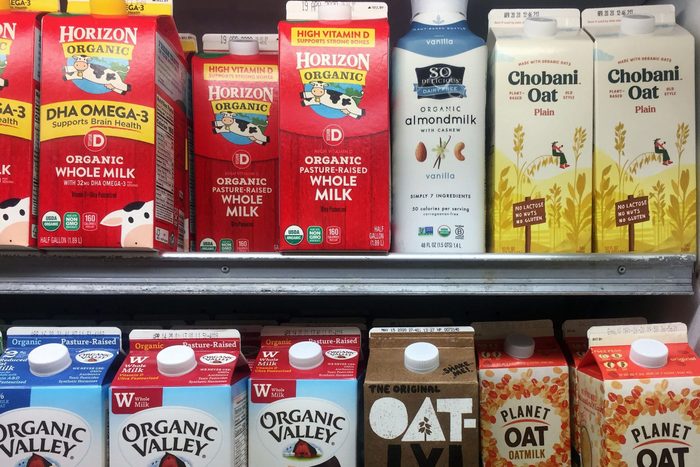Why Is Milk Always at the Back of the Grocery Store?
Updated: Mar. 15, 2023

Sure, it's nice to get some exercise, but we found out the real reason they're making you walk to get that gallon.
Have you ever wondered why one of the most popular grocery items—milk—is in the least convenient location at the store?
If you’ve ever gone to the store just to pick up a gallon of milk and walked out with an entire bag of groceries, you’re not alone. And you can blame this grocery store trick.
Why Is Milk at the Back of the Store?
It turns out that supermarkets always put their milk in the back corner to force shoppers to walk through the whole store to get there. This increases customers’ chances of grabbing other items on the way.
There’s even more strategy involved, according to food writer Michael Pollan. In an interview with NPR’s Planet Money team, he speculated that because milk and bread top a majority of grocery lists, stores separate the dairy and baked goods on purpose, forcing customers to cover even more ground.
Then again, another theory is that the back of the store is more convenient for milk delivery trucks to access, and putting the dairy section in the back cuts the time that products are exposed to warmer temps. You might be surprised to find out you’re storing your carton of milk wrong at home. Find out the best way to avoid this common food storage mistake, along with other foods.
How to Avoid Supermarket Traps
According to Paco Underhill, author of Why We Buy: The Science of Shopping, “Nothing in the store is by accident. Everything is by design.” Think about the check-out aisle—both sides stocked with candy, gum and other goodies. Stores know that people are more likely to snag a couple Kit Kats or grab a pack of Altoids while they wait for the customer ahead of them to finish up. In fact, 60% of shoppers admit to giving in!
This isn’t the only trick you’ll find in Aisle 5—most supermarkets have a method to organizing their shelves, as well. They place the most expensive products at eye level and put the cheaper or less popular ones at the top and bottom. It works, too: Think about the last time you bought something on the very top shelf.
Even more dangerous are the items right below eye level. These are the products in children’s line of sight, and they’re often marketed toward kids. Think high-sugar snacks, cereals with cartoon characters and colorful cookies.
We all want to save money, so how can we avoid these grocery store temptations? Start by making a grocery list and sticking to it. As long as your list doesn’t include “10 impulse buys on the way to the milk plus a pack of Mentos at the check-out,” you should be safe.
Another way to avoid these traps is by avoiding the store in general. Use grocery shopping apps to help make conscious decisions on what you want to purchase. Plus, grocery apps can save you hours of time if you can opt for grocery delivery right to your door!
